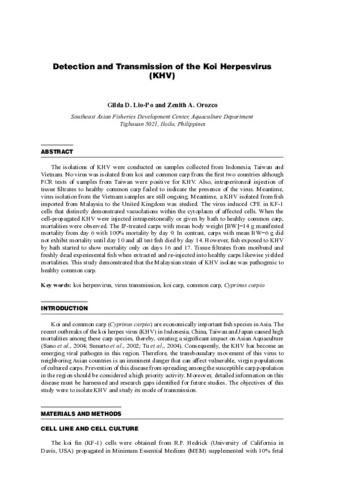Detection and transmission of the koi herpesvirus (KHV)
| dc.contributor.author | Lio-Po, Gilda D. | |
| dc.contributor.author | Orozco, Zenith A. | |
| dc.contributor.editor | Nagasawa, Kazuya | |
| dc.date.accessioned | 2020-07-23T08:19:34Z | |
| dc.date.available | 2020-07-23T08:19:34Z | |
| dc.date.issued | 2005-03 | |
| dc.identifier.citation | Lio-Po, G. D., & Orozco, Z. A. (2005). Detection and transmission of the koi herpesvirus (KHV). In K. Nagasawa (Ed.), Recent Advances in Diagnosis and Prevention of Fish and Shrimp Diseases in Southeast Asia (pp. 367–370). Tigbauan, Iloilo, Philippines: Aquaculture Department, Southeast Asian Fisheries Development Center. | en |
| dc.identifier.isbn | 9718511732 | |
| dc.identifier.uri | http://hdl.handle.net/10862/5942 | |
| dc.description.abstract | The isolations of KHV were conducted on samples collected from Indonesia, Taiwan and Vietnam. No virus was isolated from koi and common carp from the first two countries although PCR tests of samples from Taiwan were positive for KHV. Also, intraperitoneal injection of tissue filtrates to healthy common carp failed to indicate the presence of the virus. Meantime, virus isolation from the Vietnam samples are still ongoing. Meantime, a KHV isolated from fish imported from Malaysia to the United Kingdom was studied. The virus induced CPE in KF-1 cells that distinctly demonstrated vacuolations within the cytoplasm of affected cells. When the cell-propagated KHV were injected intraperitoneally or given by bath to healthy common carp, mortalities were observed. The IP-treated carps with mean body weight [BW]=14 g manifested mortality from day 6 with 100% mortality by day 9. In contrast, carps with mean BW=6 g did not exhibit mortality until day 10 and all test fish died by day 14. However, fish exposed to KHV by bath started to show mortality only on days 16 and 17. Tissue filtrates from moribund and freshly dead experimental fish when extracted and re-injected into healthy carps likewise yielded mortalities. This study demonstrated that the Malaysian strain of KHV isolate was pathogenic to healthy common carp. | en |
| dc.language.iso | en | en |
| dc.publisher | Aquaculture Department, Southeast Asian Fisheries Development Center | en |
| dc.subject | carp | en |
| dc.subject | Cyprinus carpio | en |
| dc.subject | pathogenicity | en |
| dc.title | Detection and transmission of the koi herpesvirus (KHV) | en |
| dc.type | Book chapter | en |
| dc.citation.spage | 367 | en |
| dc.citation.epage | 370 | en |
| dc.citation.bookTitle | Recent Advances in Diagnosis and Prevention of Fish and Shrimp Diseases in Southeast Asia | en |
| dc.subject.asfa | disease recognition | en |
| dc.subject.asfa | fish diseases | en |
| dc.subject.asfa | viruses | en |
| dc.subject.asfa | cell culture | en |
Files in this item
รายการนี้ปรากฏใน (s)
-
Recent Advances in Diagnosis and Prevention of Fish and Shrimp Diseases in Southeast Asia [43]
Terminal Report of the Regional Fish Disease Project on “Development of Fish Disease Inspection Methodologies for Artificially-Bred Seeds” Funded by the Government of Japan Trust Fund from 2000 to 2004


 AQD Access only
AQD Access only